Spokane Doesn’t Suck, Really
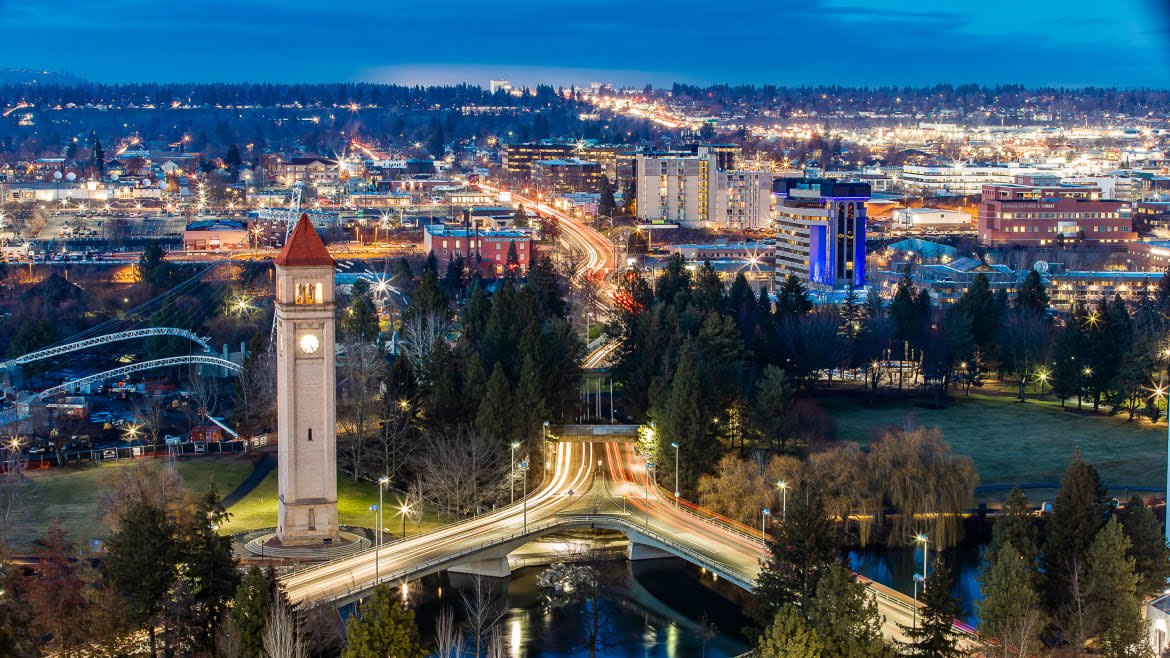
- Oops!Something went wrong.Please try again later.
This is the latest in our twice-a-month series on underrated destinations, It’s Still a Big World.
Like any city, Spokane is more than what little outsiders like myself might know. Spokane is more than Murphy’s future “New World Order” in the zombie series, Z Nation, more than the set of Macklemore’s Downtown, and more than the curse put on it in 1986 by a self-proclaimed Romani leader after an illegal police raid on his property.
It is also more than just Washington’s second-largest city and more than its complicated past. Spokane is an accessible city that balances the outdoor world with a food scene ready for the hungry after a day in the sun. To borrow from an unofficial city slogan many locals like to use: “Spokane Doesn’t Suck.”
Sitting to the far northeast of Washington along the Spokane River, and approximately 20 miles from the Idaho state line, Spokane became a city in 1881 with a population of 350 settlers—today it has nearly 230,000 residents, with the greater area being around 540,000. For millennia, though, it has been the ancestral land of its original inhabitants, the Salish speaking Spokane Tribe—“Spokane” meaning, “Children of the Sun.”
But there was so much about Spokane that I knew nothing about. So at the invitation of Visit Spokane, I went for two days to find out more.
I started my time in Spokane diving into the food. My guide, Kate Hudson (no, not that one), the regular face of Visit Spokane on TV and former broadcast journalist, introduced me to the food and inviting space of Wooden City, which sits in the heart of downtown, and just a few blocks from the Spokane River. For an appetizer, I started with their blistered Hungarian peppers (sweet sausage, aged cheddar, chive oil, served with toasted ciabatta) and I cherished every single, rich bite of it. And while they are known for their wood-fired pizzas, I decided on local fish, and had the very satisfying, pan-seared steelhead (with smoked ham, fingerling potatoes, olives, cipollini onion, tarragon, and sauce gribiche).
Unlike many of my other trips, I was also on a mission to explore some non-alcoholic cocktails for once. A lot of travel writing, including my own, feature cocktails and miss out on some of the creative options for those who do not imbibe. Wooden City has a refreshing zero proof selection, like Shrub & Soda (berry shrub, ginger beer, citrus) and Lavender Lemonade (thyme syrup, lemon, demerara, and lavender soda).
(Be forewarned: I did a lot of eating on this trip and I don’t regret a single minute of it.)
My home for my visit was the historic Davenport Hotel, an over 100-year old iconic hotel boasting an ornate lobby and ballrooms, as well as fine dining. I stayed in a spacious king room, outfitted with a seating area, fireplace, and large walk-in showers ($300+). There are beautiful decorative features and architectural callbacks around every corner of the building. One venue at the hotel, The Hall of the Doges, was inspired by the Doge’s Palace in Venice and is built in the Venetian Gothic style.
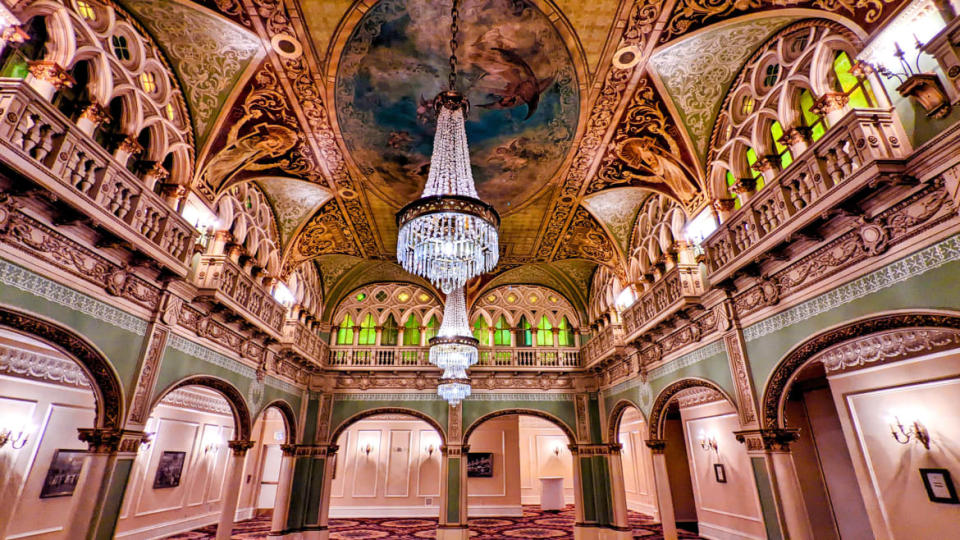
The next morning, I started my day (without a hangover) by ordering lemon blueberry waffles at The People’s Waffle, a former food truck that recently became a brick and mortar, just a couple of blocks away from Riverfront Park, our next stop.
Riverfront Park is a wonderful green space where people gather for events, to get lunch from a food truck, or to use multi-purpose trails, like the 40-mile, and wheelchair accessible, Centennial Trail along the Spokane River. The trail connects downtown with Gonzaga University, as well as multiple trails that lead to parks and which connect both Washington and Idaho. (Lime scooters and eBikes are available.)
I love destinations that invest in trails. Any city that is not investing in its active transportation is not serving its people.
But Riverfront Park is more than a greenspace—it also has an interesting history.
The park sits just before Spokane Falls downtown, which are part of the Spokane Tribe’s unceded territory, and for thousands of years this area served as the place that tribes throughout the region gathered to share the supply of Chinook salmon. The Salmon Chief was responsible for maintaining an even distribution of salmon for everyone. Today, dams prevent salmon from making their migration, but that history is still honored through the Gathering at the Falls Pow Wow annually.
Ongoing conversation and debate about how to reintroduce salmon to the region continue, as do steps on the long road to reconciliation. For example, Spokane City Council issued a land acknowledgment statement last year.
This area changed a lot in a short period of time.
Just 50 years ago, Riverfront was an old, filthy rail yard, which was cleaned up to become the site of the first environmentally themed World’s Fair in 1974. You wouldn’t know that rail yard history by strictly looking at it. The only reminder is a clocktower built in 1902 that still stands on Havermale Island and is still in operation. (Someone has to climb the five stories of the tower and crank it 99 times every week to keep it going.) The park’s open pavilion, which was created for the World’s Fair, underwent some updates in 2019 and now lights up on weekends and hosts concerts.
There is also plenty for families to see and do in the park.
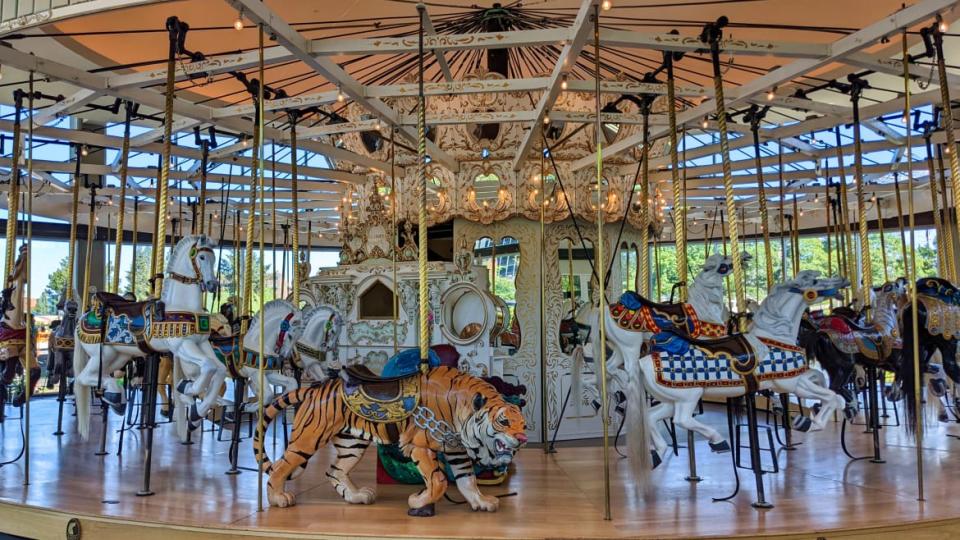
The Looff Carrousel, for example, was built in 1909 and has its original hand-carved wooden animals to ride. It includes a ring dispenser, which allows passing riders to grab a ring to toss at a clown target. The Garbage Goat is a goat sculpture-garbage can, which sucks up your garbage. (Okay, so yes, at least one thing about Spokane sucks.) The Numerica SkyRide offers cable rides on the gondola lift every 15 minutes over the river and the Spokane Falls. The ride gives you great views of the river and the falls, though they are at their fullest from March to June.
After riding the trail and seeing the park, it was time for something that I’ve been chomping-at-the-bit to do: zipline.
But first, I fueled up at a Spokane institution: Domini’s. (It also happens to be the name of a good friend of mine, so it felt like a must.) Domini’s is known for two things: every order gets a bag of popcorn and their sandwiches are simple—as in bread, meat, and cheese. Their sizes are distortions of scale. The tiny (which is not as big as the small) is easily the size of any regular sandwich that can be found anywhere else.
But now about that zipline.
I always love ziplining. When I can fit it into a trip, I usually try. Fortunately, Kate was eager to jump from trees too. Mica Moon’s Classic Zipline Tour (adults $109; youth and seniors, $99) is one of those experiences that is worth every penny. As is standard with most zipline tours, you begin with the shortest and easiest and work your way up. Each of Mica Moon’s zips get higher, longer, and faster until you reach the one they call Big Mamma, named after a round, sloping mountain side in the distance, which is shaped like a pregnant belly. That was the zipline I came to see. We were halfway up the Mica Peak, which is just south of Liberty Lake, WA in the greater Spokane area. The view was sweeping, and high-up over the pines rolling up the mountainside.
“How fast does this one get to?” I asked.
“Probably 50 mph or so,” one of the guides tells me. “It’s approximately 3,500 feet long.”
After three hours, eight ziplines, ATV rides, hikes, and a bridge, this final zip, which takes around one minute to complete, is the only way down. When you launch off the platform, your speed picks up matching the ever-rising pitch the cable makes as you’re zipping down. There’s only one thing to do—embrace that beautiful feeling as you soar down into a valley and through the tree canopies that feel close enough to touch.
Kate and I returned to the city to get drinks at the speakeasy, Cease & Desist Book Club. I know that every city now has a growing segment of bars that reflect the 1920s speakeasy, but when I’m in a new city, it’s become a thing for me to see how a bar might reflect that theme. Cease & Desist wasn’t their first name. Originally called Scofflaw Book Club (scofflaw is someone who flouts the law), they received a cease and desist order from a brewer by the same name—and so they became the Cease & Desist Book Club. Frankly, I like the name, and the in-your-face-attitude behind it, much better.
When you walk in the front door of Cease & Desist, you’re greeted by bookshelves, as if you are in a simple bookstore, but pull on the right book and a door opens to a stylish and dark atmosphere with a wonderfully amber-lit bar. Cease & Desist has classic cocktails, like the Corpse Reviver, Manhattan, Old Fashioned, several seasonal cocktails, over 100 whiskies to choose from, wine, and even mocktails—like The Berry Thirsty Mule (lime juice, mixed berry puree, ginger bear, berry and lime garnish). If you love a good craft cocktail, this is a must visit.
But a man does not live by drinks alone.
Kate and I hopped over to Zona Blanca, a new restaurant owned by two-time James Beard finalist and former Season 13 of Top Chef contestant, Chad White. Zona Blanca’s menu features Mexican coastal flavors and every quarter, they have a temporary menu based on a state in Mexico, which while I was there was Sonora.
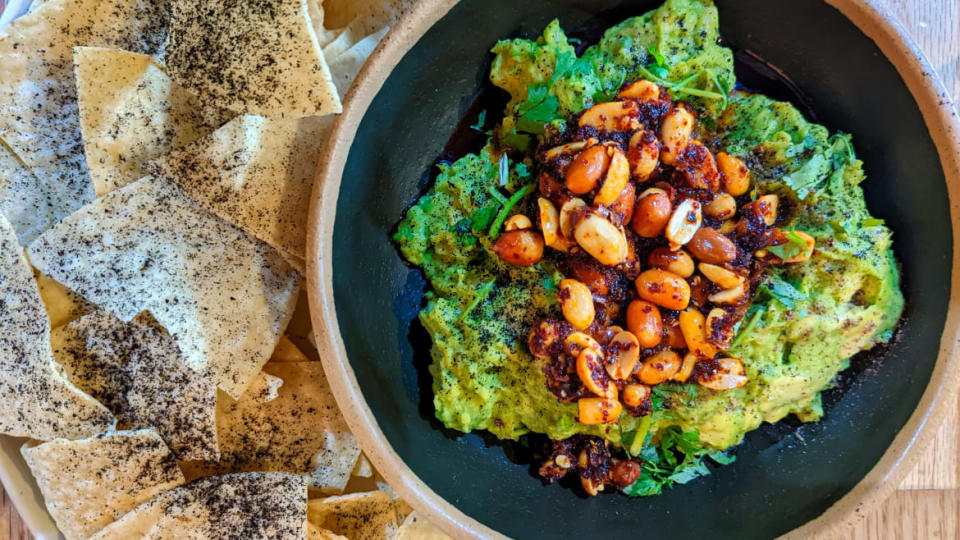
While they specialize in ceviche, there are a variety of other options on the menu, like oysters (their shooters are oysters, quail eggs, and baja ponzu), tacos, and tostados. I sampled the menu, but what stood out to me was the spicy guacamole, with lime, cilantro, tortilla chips, salsa de cacahuates, and notably sal de chapulines (cricket salt—yes, those kinds of crickets). They also made a fantastic tepache cocktail (house-made spiced and fermented pineapple hooch with a choice of tequila, mezcal or rum), which I had as zero proof and it was fantastic.
The next day, we got pastries and coffee at Rockwood Bakery, and then hit the road for more time outdoors. The first stop was Manito Park in the city, which was established in 1904 and includes five beautiful gardens—the Nishinomiya Tsutakawa Japanese Garden, Duncan Garden, Rose Hill, Lilac Garden, and Ferris Perennial Garden. All are free.
We then followed-up our time in nature with more time in nature, hiking through Turnbull National Wildlife Refuge, a 20,000-acre preserve approximately 40 minutes from Spokane, which consists of wetlands and prairies, and plenty of opportunity for birding if you arrive early or later in the evenings. Turnbull is also a very quiet area with miles of trails if you’re looking to get lost in nature.
After a nice hike, I was introduced to The Grain Shed, a sustainable brewery and bakery cooperative, that sets out to be connected to the local community and use regeneratively grown regional ingredients. Its breads—and the scent of baked bread that fills the air there—are amazing.
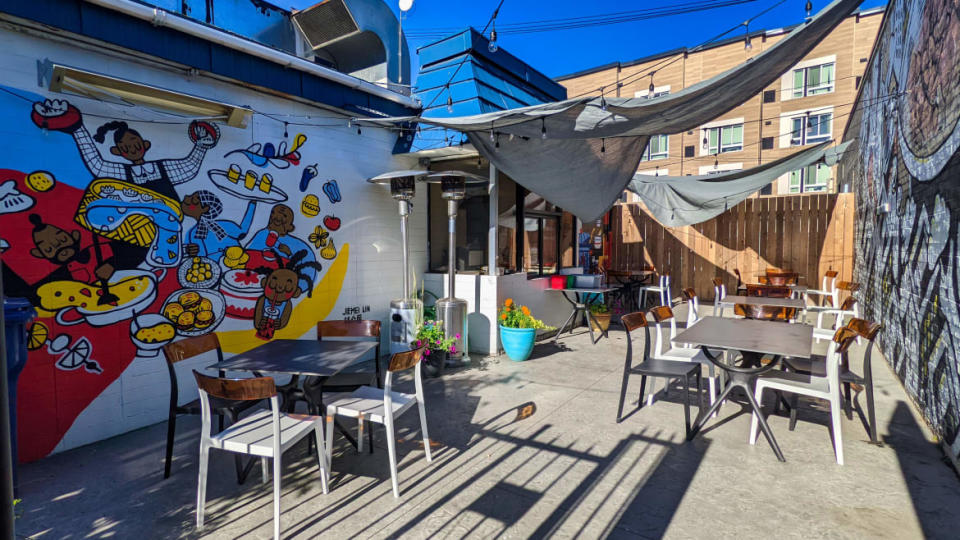
Later in the evening, we stopped by Feast World Kitchen, whose tagline is “Less Fear, More Falafel.” Feast World Kitchen is a non-profit where the changing variety of the menu is driven by refugee and immigrant chefs. This welcoming restaurant is in the middle of downtown Spokane and brings the world’s kitchens—Korean, Ethiopian, Syrian, you name it—to the greater community while also teaching career skills and enabling entrepreneur chefs to make a living. When I visited I had the chicken shawarma wrap from Abdulkareem Mahmoud’s Syrian menu. Menus are posted on their website and they have rotations from Wednesday to Sunday.
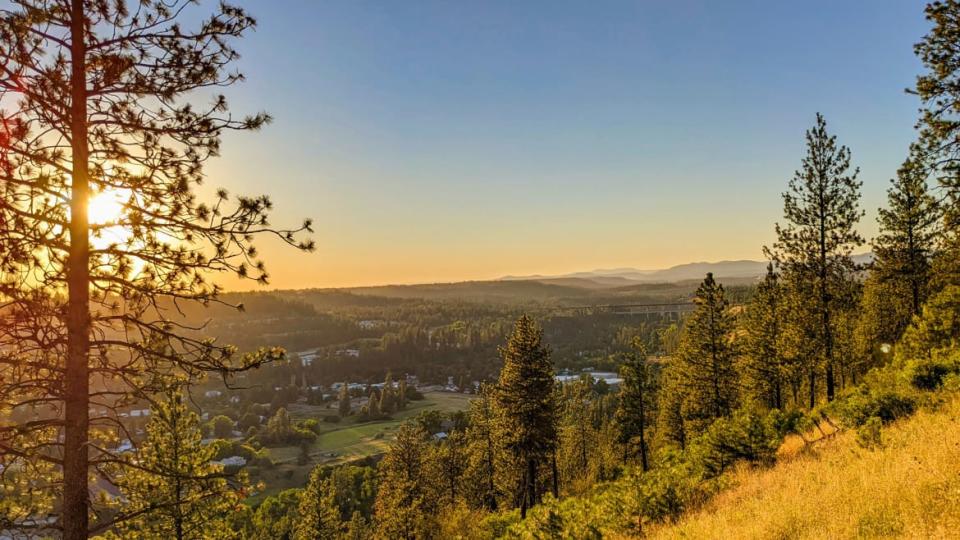
I ended my day with a sunset hike along High Drive Bluff. Along Spokane’s South Hill, there are 20 miles of trails that are used by hikers, runners, mountain bikers, and birders with the advantage of also having a perfect sunset view. We watched the sun go down over the peaks in the distance and I said goodbye to my last night in the city.
Maybe it’s because I come from the underrated city of Toledo, Ohio—which is about the same size as Spokane—but when I visit places like this, I enjoy seeing what the people who live there enjoy doing. What new restaurants are they getting excited about? Where do they like to go to spend time outdoors? Why don’t they suck?
Spokane is one of those cities that not only surprise you with what they have hidden and tucked away in different neighborhoods, it leaves you thinking: two days is just not enough, I need to go back.
Get the Daily Beast's biggest scoops and scandals delivered right to your inbox. Sign up now.
Stay informed and gain unlimited access to the Daily Beast's unmatched reporting. Subscribe now.

